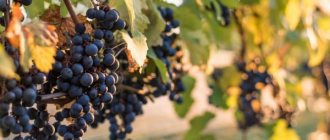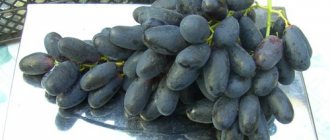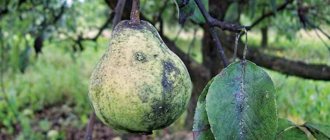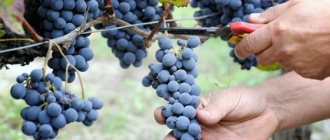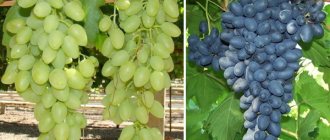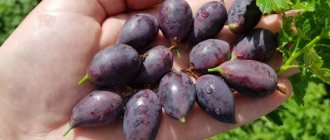The Everest grape was bred by amateur breeder Evgeniy Georgievich Pavlovsky. The created hybrid variety is truly successful and worthy of special attention from farmers and winemakers. Everest berries are distinguished by their aroma and bright taste, as well as an excellent ratio of grape acids to sugars. This relatively new table variety is actively used not only as a raw material for winemaking, but is also often consumed fresh. The parent pair “talisman” and “k-81” provided the hybrid in question with excellent taste and commercial qualities, as well as relatively high frost resistance and resistance to dry periods.
Berries
The fruits have a uniform, beautiful pink color. At the beginning of ripening, the grapes appear tinged with a slight addition of pink. When fully ripe and overripe, the berry of the hybrid in question acquires a dark burgundy hue. It is important to note that the fruits of the Everest grape variety tend to fade slightly in the sun, while the shadow side preserves the brightness of the color. Given this property, farmers are in no hurry to open the berries to the sun's rays.
Not all berries begin to acquire their color at once, but only those that have already gained a mass of at least 15 grams. Other grapes ripen patiently and only then catch up in color to the first ones. Ripe berries weigh on average 18–20 grams each. However, the scales sometimes indicated the weight of Everest grape fruits up to 25 grams.
The shape of the grapes is oval with a slightly narrowed tip, the length of the berries is 4.5 cm, and the seed is 1 cm long. Initially, it may seem that the fruits are incorrectly formed, but the proportions are still respected.
According to the tasting assessment (the photo of the Everest grapes also indirectly confirms this), the hybrid is defined as a plant with an attractive appearance and harmonious taste. The skin gives the berry fruity notes; it is medium in thickness, but perfectly chewable. There is practically no nutmeg taste. The proportion of sugars and organic acids is balanced. All this makes the hybrid pleasant to eat both for lovers of sweet varieties and for those who do not like to taste sugar.
Features of the Everest hybrid form are presented in the table:
| Variety | name "Everest" |
| Selection | folk, Pavlovsky E.G. |
| Growing season | 115 days |
| Frost resistance | -21-23′ C |
| Disease resistance, points | average resistance 3 points on a five-point scale, preventive treatments are required |
| Incomplete pollination (Peas) | rarely |
| Sugar content | 18- 19% |
| acid titers | 6-7g/l |
| aroma | harmonious with a light fruity aftertaste |
| Raw materials for wine | inappropriate |
| Consumed raw | table grape variety |
| Long distance transportation | It tolerates transportation very well, due to the fact that the berries adhere tightly to the ridges and are not subject to cracking. |
| Requirements for soil | needs fertilizing rich in microelements, loves watering, fertile sandy black soils |
| Productivity | 20-25 kilograms per adult plant |
| Color features | The berries are covered with a thin pruin and have a pink-red color, which turns purple when hanging on the bushes for a long time. |
| Fruit size | The length of the berries is about 25-30 and the width is 20-25 millimeters |
| Fruit shape and weight | Weight of berries is 16-20 grams. The shape of the berries is oval. |
Bunches
Many farmers note that Everest grapes have beautiful symmetrical clusters, dense, with long branches, voluminous and slightly elongated. They reach a length of up to 35–40 cm and a weight of about 0.7–1 kg. In a bunch, the grapes hang very tightly to each other.
Harvesting occurs in 3–4 years. Even without the formation of a sufficient amount of wood, the Everest grape bush produces clusters weighing up to 1.2–1.5 kg. However, during this period, the appearance of uneven shoots can be observed. One bush can produce both very large clusters and those that weigh no more than 0.5 kg.
Good pollination of the crop allows you to get a large and beautiful berry, but only after good thinning. The shape of the vine is conical with well-defined wings.
Marketability
According to the description of the Everest grape, the berry has high rates of transportability. The medium-thick skin protects the fruit well from negative environmental influences and all kinds of damage. The berries can easily withstand long-term transportation and are stored well.
One of the special characteristics of this hybrid is its attractive presentation. At the market, such bunches are hard to miss and pass by. According to the description of the Everest grape variety, the fruits are:
- do not crack;
- stay on the bush for a long time, without changing their organoleptic properties;
- have high transportability even over long distances;
- They are stored for a long time after being cut from the bush.
A distinctive feature of the hybrid berries when ripe is that after “sagging” for up to 30 days, they soften a little at the tips, this indicates over-ripening. The state of over-ripening is not a minus for the fruits of Everest grapes, but it is better to pick the berries on time, according to the ripening period.
Botanical description
The Everest grape was bred by the famous breeder E.G.
Pavlovsky by crossing the varieties Talisman and K-81. The hybrid ripens in the mid-early period - in the last ten days of August or September. The period from bud break to harvest is 110-120 days. The Everest variety has a table purpose. The clusters are large, weighing 700 g, in the shape of a cone or cylinder, of medium density.
The bushes have great growth vigor and form powerful shoots. The flowers are bisexual, planting pollinators is optional.
Description of the variety and photo of Everest grapes:
- large berries;
- average fruit weight 12 g;
- oval shape of berries;
- red-violet color;
- thick waxy coating.
The berries are distinguished by their fleshy and juicy pulp. The taste is simple but harmonious. The fruits are not subject to rotting and cracking. Berries on one bunch may differ in size and color.
After ripening, the clusters can remain on the bushes for a month. After aging, the taste only improves, and nutmeg notes appear in the berries.
Everest berries are consumed fresh and used for making desserts, jams, and juices. The fruits tolerate long-term transportation well.
Taste
The taste properties of the Everest table variety are good, the fruit pulp is juicy and even slightly crunchy. The skin is well fused with the pulp, has medium thickness and is quite easy to chew. There are no more than two seeds in each grape, and they are easily cracked without emitting bitterness. The fruits gain sugar quickly, and the balance of acids in them is such that even at the beginning of the ripening period they acquire a pleasant taste and do not become sour. Subsequent ripening of the fruit only improves its taste.
Advantages and disadvantages of the variety
According to the description, the Everest grape variety, the photo of which is presented below, has the following advantages:
- farmers can count on an early and stable harvest;
- grape berries have an attractive appearance and excellent taste;
- no tendency to pea;
- there is no rapid cracking of fruits;
- excellent rooting of cuttings;
- high adaptability to all kinds of climatic conditions;
- resistance to major diseases and damage by pathogenic microorganisms;
- the crop is transported well.
Let us also highlight the disadvantages of the variety:
- still unstudied winter hardiness;
- the crop should be additionally insulated;
- A huge area is required for cultivation.
Subtleties of landing
According to reviews, descriptions and photos of the variety, Everest grapes are propagated by seeds, cuttings, by grafting cuttings to seedlings or by grafting another variety. The second method takes a significant amount of time. Many winegrowers initially sow seeds in a plastic or peat pot. When the young grapes reach a height of 10–15 cm, they are transferred to open ground. This process takes on average 2–3 years.
Propagation by cuttings is quite feasible only if there is already at least one Everest grape bush on the site. To do this, one or more strong vines are bent down and covered with soil. Reproduction in this way is recommended in spring or autumn.
Many farmers recommend planting the unpretentious and undemanding Everest variety in the second half of April. The planting site should be found on a hill with normal protection from the wind and good lighting, which is important for crop formation.
Almost any soil is suitable for growing crops. "Everest" can successfully produce crops even when growing on rocky slopes. The main advice is to avoid close proximity to groundwater and places where spring flooding occurs.
According to the experience of many farmers, the crop likes to grow best on the south side. When forming holes for planting grapes, half a bucket of humus is placed at the bottom.
Care methods
Everest is an unpretentious variety and does not require a special agrotechnical approach. All procedures are standard.
Watering
The watering procedure is carried out before the seedling is three years old. The first time is irrigated at the moment the buds open, the second time some time before the grapes bloom, and the third time when the Everest clusters ripen. When a variety is already four years old or more, it is capable of extracting the moisture it needs from the ground. For Everest they use warm, settled water in barrels. It is necessary not to expose the grapes to volumetric accumulation of moisture, as this will inhibit the growth and development of the vine, and the roots of the grapes will rot.
Top dressing
The application of fertilizers has a good effect on the harvest obtained from Everest. Each grape bush requires mineral and organic substances. Thus, in the spring, nitrogen supplements are added and the grapes are watered in a ratio of 1 × 20 with solutions of urea and mullein. After flowering, Everest is treated with solutions of superphosphate and potassium salt. The same scheme is repeated after delivery. In autumn, the soil is dug up. At the same time, two buckets of humus are added for each square meter.
Pruning and shaping grapes
To balance the load, Everest is formed and trimmed. For this variety, it is necessary to leave only four vines, and each should have about 8-10 eyes. This activity is carried out in the fall after the leaves have fallen. In the spring, it is recommended to inspect the grapes for the presence of dry and frozen areas (they should be cut out). In summer, the variety needs to be thinned out. To do this, remove the stepsons and leaves that help close the brushes. It is recommended to carry out the procedure so that two inflorescences remain on each shoot.
So, the grapes will ripen faster, the load will be reduced, and the bunches will be larger.
Preparing for winter time
Although the variety has good resistance to frost, it is susceptible to its effects. If the temperature drops below -22 degrees Celsius, then the grapes may well suffer and even die if protection and shelter measures are not used. It is not recommended to cover with polyethylene! To protect the variety, two weeks before frost, the vine is removed from the trellis. Shields or boards are installed next to the grape bushes (Everest shoots are laid on them). Then the variety is covered with sawdust or cloth. And the top is covered with a waterproof material (for example, roofing felt).
Grape resistance to frost and disease
Today it has not yet been clarified whether it is possible to obtain a normal harvest if the crop is planted in the northern regions of the country. Therefore, it is impossible to declare 100% that “Everest” is completely frost-resistant.
Winter hardiness, according to reviews of Everest grapes, has not yet been sufficiently studied. Since the hybrid was created relatively recently, many experts have not yet had time to study it well. To avoid crop loss, farmers advise that the plant be insulated for the winter. In autumn, when the first frost occurs, it is important to wrap the grape bushes using the dry method. That is, the vine is carefully rolled up and placed on pre-prepared boards. The branches are covered with several layers of non-woven material. Many farmers cover the vines with dry sawdust. After the branches have been insulated, be sure to construct a top layer of film or roofing material; it will help protect the crop from moisture.
The first treatment measures should be carried out when young leaves appear. To do this, you can use “Tiovit Jet” in a dosage of 40 grams per 9–10 liters of water. Such treatment will prevent the development of diseases such as oidium, Phomopsis and rubella.
“Everest” did not show a tendency to be highly infected with diseases. The crop is not susceptible to dangerous diseases such as powdery mildew, mildew, and gray rot. However, the key to a high-quality harvest is precisely the preventive treatment of the crop. The presence of a dense skin reliably protects the juicy pulp from insects and small pests. Grapes are not afraid of bees and wasps.
Main characteristics
Grapes century
"Everest" is characterized by a short growing season. From the moment the buds open, the fruits ripen after 120 days. This allows you to harvest ripe and juicy fruits already in mid-August.
Bushes
The Everest variety takes root well and easily adapts to environmental conditions. The bushes are characterized by good growth vigor and excellent ripening of the vine along the entire length. The formation of a large number of fruit-bearing stepsons greatly facilitates the reproduction process. However, due to the presence of large bunches, it is necessary to monitor the load on the bush and prune it on time.
Flowers
The presence of bisexual flowers has a beneficial effect on the process of reproduction and development. This allows the plant not only to pollinate itself, but also to participate in the pollination of other crops. The proximity of “Everest” to grape varieties with unisexual flowers is very advantageous.
Bunches and berries
Large clusters of grapes deserve special attention. They have a cylindrical shape and a dense structure in which the berries are located close to each other. The weight of an individual bunch varies from 0.6 to 1.2 kg.
The berries are large, oval in shape, weighing 15-25 g. The pulp is juicy and dense, covered with a thin but durable skin that is barely perceptible while eating. The amazing dark red color of the berries, covered with a thick pruin coating, gives them a chic appearance. “Everest” received excellent taste thanks to its pleasant sweet taste and harmonious aroma.
Productivity
High yield rates never cease to amaze winegrowers. Excellent commercial qualities and appearance allow the variety to be bred for personal use and for sale. Beautiful and large fruits are just beginning to conquer the market, but the demand for them is increasing every year.
Transportability
Bunches of grapes have good transportability. The reliable skin perfectly protects the berries from external influences and damage. The fruits can easily withstand long-term transportation and are stored well.
Frost resistance
Due to little study of the variety, the frost resistance threshold of grapes is not known. However, Everest has proven its resistance to slight cold and frost. This allows the crop to be grown not only in the southern but also in the middle regions.
Advice! In order to prevent and protect the plant from freezing, it is recommended to cover the bushes for the winter. The reliability and durability of the covering material depends on the climatic conditions of the area.
Resistance to diseases and pests
Everest did not show a tendency to be highly susceptible to diseases. It is not susceptible to the most dangerous diseases, such as oidium, mildew, and gray rot. However, the key to a high-quality harvest will be preventive treatment of grapes. The presence of a dense skin reliably protects the juicy pulp from insects and small pests. Grapes and wasps are not afraid.
Prevention measures
In order to protect plants from insects, rodents and fungal infections, preventive measures can be taken. The first thing experts do is spring spraying of the vines and soil. To do this, use a 3% solution of iron or copper sulfate.
The second spraying is carried out during the period of bud break and the appearance of the second leaf. To do this, take drugs with antifungal action. It is also necessary to carry out a third spraying of Everest grapes before flowering begins, for which they use “cocktails” of antifungal drugs, insecticides and foliar feeding.
Subsequent spraying of the bushes is carried out only as diseases appear, and also taking into account the epidemiological situation in the grape growing region. If specialists carried out prevention in a timely and competent manner, then further spraying may not be useful. As can be seen from the article, there is nothing difficult about growing Everest grapes.


